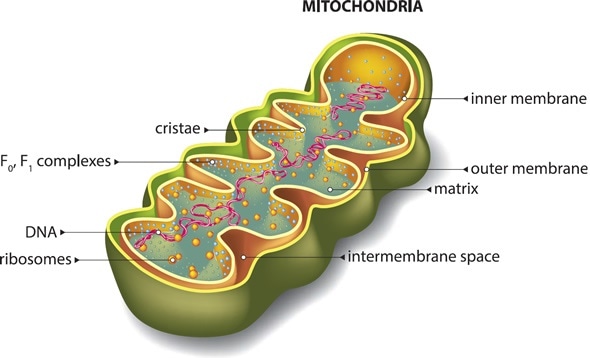Mitochondria are organelles found in the cytoplasm of most cells. They are essential to healthy living as they play an important role in the way cells function in the body. Mitochondria generate energy for cells to carry out activities. This energy is in the form of adenosine triphosphate (ATP). They also take part in cell signalling and help cells sense and adapt to their environment.
The amount of mitochondria found in cells depends on the particular types of cells. E.g., Liver cells can have as much as 2000. The amount can depend on the levels of energy required by the cell.

Section of mitochondria. Image Copyright: NoPainNoGain / Shutterstock
What is the Structure of a Mitochondrion?
A mitochondrion is an organelle about 0.75 – 3µm in diameter. Its structure, which tends to be bean-shaped, includes several compartments that carry out different important roles. However, mitochondria are not easily visible structures unless using staining of cells.
An outer mitochondrial membrane about 60 – 70Å thick containing proteins called porins surrounds a folded inner mitochondrial membrane. The outer membrane incorporates enzymes that contribute to the oxidation of adrenalin, the reduction of amino acids and the lengthening of fatty acids.
Just in between the inner and outer membranes of the mitochondrion is the intermembrane space. The inner membrane has proteins involved in several functions including redox reactions of oxidative phosphorylation, generating ATP in the matrix, regulating metabolites, importing substances as well as fusion and fission.
The inner membrane also has folds called cristae which provide a large area for the mitochondrion to carry out its reactions. This is where the energy production happens. In particular, it helps with aerobic cellular respiration.
The inner membrane surrounds a space called the matrix which has lots of enzymes, RNA, ribosomes, and mitochondrial DNA genomes.
The mitochondria-associated endoplasmic reticulum membrane (MAM) in a mitochondrion takes part in regulating the environment of the cell such as its acidity, alkalinity, and temperature.
The Role of Mitochondria in the Functions of a Cell
Mitochondria produce energy for cells through respiration. They produce ATP through a process called the citric acid cycle by oxidation of substances formed in the cytosol of the cell. A chemical called NADH is produced which is worked on by enzymes in the inner membrane, producing electrons which move around the internal system of the mitochondrion.
Mitochondria also helps maintain the environment of the cell (homeostasis) to keep the best conditions for optimum function. This is achieved by the storage and release of free calcium. Both cellular proliferation and cell division are regulated by mitochondria. Mitochondria themselves, however, actually divide by the process of binary fission.
Mitochondria also have a role in controlled cell death (apoptosis). They generate reactions which contribute to cell changes and eventually cell death. Up to 70 billion cells die in the average adult human every day. For children this is around 20 to 30 billion cells.
The Role of Mitochondria in Triggering Diseases
Mitochondria have such an important job to do in helping cells function properly that when they malfunction, they can cause diseases. Some malfunctions are believed to be due to mutations of mitochondrial DNA in about 15% of cases. Other times, mutations in genes will cause problems and lead to inherited diseases. It has been found that malfunctioning mitochondria play a role in conditions such as autism, heart failure, and cardiac dysfunction. People with Parkinson’s disease have a high level of mitochondrial mutations.
The typical symptoms of many mitochondrial diseases are loss of muscle coordination muscle weakness sight problems, liver disease, kidney disease, neurological conditions, and gastrointestinal problems to name just a few.
References
Further Reading
Last Updated: Jul 19, 2023